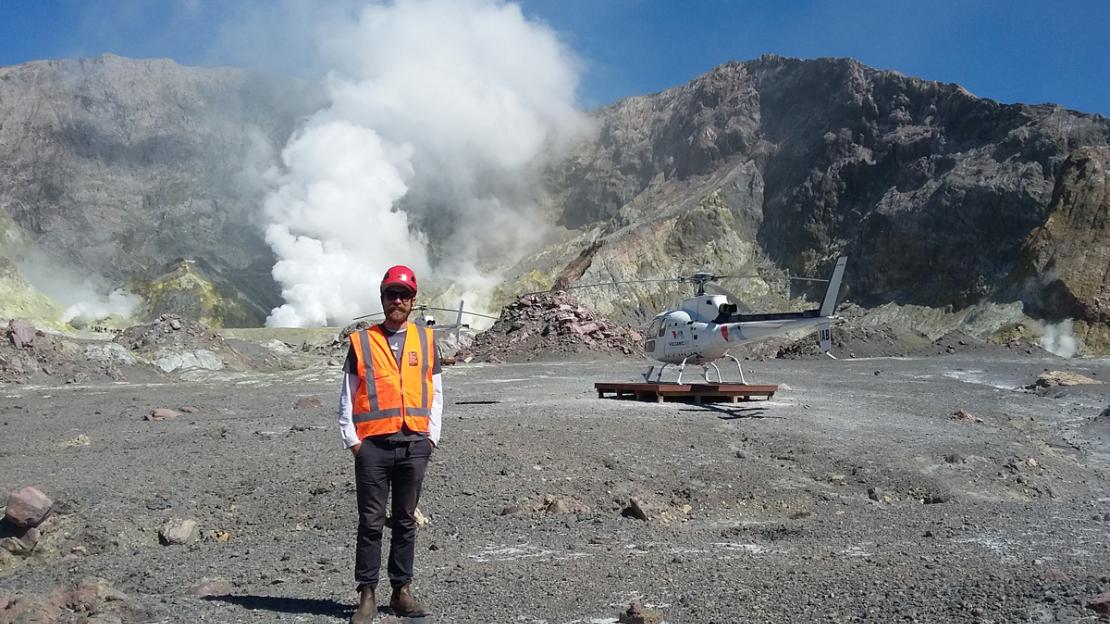David McLagan’s research has taken him to some interesting places, but going to an active volcano tops the list.
“I’ve never been to a place quite like it,” says McLagan, who deployed a series of passive air samplers on White Island, an active volcano 48 km off the coast of New Zealand’s North Island.
As a PhD candidate working under the supervision of Professors Frank Wania and Carl Mitchell in the Department of Physical and Environmental Sciences at U of T Scarborough, his research focuses on developing passive air samplers that can monitor mercury concentrations in remote locations.
And New Zealand’s White Island certainly qualifies as remote.
Located off the east coast of New Zealand’s North Island in the Bay of Plenty, the island is open to tourists but is only accessible by helicopter or boat. In planning for the trip McLagan connected with GNS Science, a local public-private research organization that monitors volcanic activity on the island and across New Zealand. Along with crucial logistical support, they also provided extensive training on how to conduct research safely on the island. Meanwhile, McLagan received funding for the research trip to New Zealand from U of T's Centre for Global Change Science (CGCS).
White Island is an active volcano that spews out huge amounts of gas, so masks are necessary to avoid passing out from noxious vapours continuously being vented. In addition to hard hat and boots, walking with a prodder was also important to avoid soft spots in the ground that could burn feet.
There’s also the ever-present risk of eruption, but McLagan felt reassured by the team at GNS who take extra precautions. They aren’t allowed to travel to the island if any unusual seismic activity is recorded, even if it’s still deemed safe for tourists. The island was also once home to a sulfur mine where an eruption in 1914 killed all of the miners working there. The decayed remains of the mining buildings can still be seen on the island.
While in New Zealand McLagan also deployed his air samplers at another site called Craters of the Moon, the largest geothermal field in the country. The site gets its name from its unearthly appearance, one that is barren yet bright, with constantly shifting ground and endless steam vents dotting the landscape.
Since there’s no electricity in these remote locations – nor is it possible to supply tanks of argon gas that active air samplers rely on – the passive air sampler developed by McLagan uses the natural movements of air and a carbon material to capture mercury in the atmosphere.
It’s important to monitor mercury in the air since it can last in the atmosphere for around a year and can be transported great distances, says McLagan. Once it reacts with oxidants, it can be deposited as an environmental contaminant.
As it works its way into unoxygenated sediments it can be transformed into methylmercury, which is the most toxic and the most alarming from a human health perspective. Since it’s a neurotoxin, it’s been linked to a host of brain and nervous system disorders, and that are especially concerning for fetal and infant cognitive development.
Another study by McLagan took him to a shuttered mercury mine in Italy to measure concentrations in the buildings and surrounding area. Emissions from this mine remain a concern because it’s located close to the community of Abbadia San Salvatore in Southern Tuscany. He also witnessed small droplets of liquid mercury on the ground inside old mining buildings, but it all doesn’t seem to bother him.
“In terms of exposure, there is a lot of mercury there, so I wouldn’t want to spend a lot of time in those mining buildings,” he says. “We’re careful not to spend more than five minutes or so.”
While mining for mercury is no longer allowed in most parts of the world, McLagan says there’s been a rise in emissions from small-scale gold mining operations in the developing world. He adds while active air sampling of mercury is common in affluent countries in the northern hemisphere, there are fewer than ten remote sites in the southern hemisphere that are currently monitoring mercury. The ultimate goal of his research is to help resolve these spatial imbalances that exist in mercury monitoring across the globe.
“Being able to go to these places and collaborate with researchers from around the world, it’s just a great professional and personal experience.”
